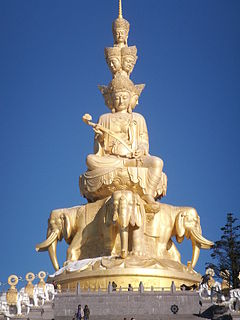
Back Самантабхадра Bulgarian সামন্তভদ্র Bengali/Bangla ཀུན་ཏུ་བཟང་པོ། Tibetan Samantabhadra Catalan Puō-hièng Bù-sák CDO Samantabhadra Czech Samantabhadra German Samantabadro Esperanto Samantabhadra Spanish سامانتا بادرا (بودیساتوا) Persian
| Samantabhadra | |
|---|---|
 | |
| Sanskrit | समन्तभद्र
Samantabhadra |
| Chinese | 普賢菩薩 普贤菩萨
(Pinyin: Pǔxián Púsà) (Jyutping: pou2 jin4 pou4 saat3) (Southern Min: Phó͘-hiân Phô͘-sat) |
| Japanese | 普賢菩薩
(romaji: Fugen Bosatsu) |
| Khmer | សមន្តភទ្រ (sa-mun-ta-phoat) |
| Korean | 보현보살
(RR: Bohyeon Bosal) |
| Mongolian | үндэсамбуу Самандабадраа Хамгаар Сайн |
| Tagalog | Samantabhadla (Baybayin: ᜐᜋᜈ᜔ᜆᜊ᜔ᜑᜇ᜔ᜎ) |
| Thai | พระสมันตภัทรโพธิสัตว์ Phra Samantaphat Phothisat |
| Tibetan | ཀུན་ཏུ་བཟང་པོ་ Wylie: kun tu bzang po THL: küntuzangpo |
| Vietnamese | Phổ Hiền Bồ Tát (Chữ Hán: 普賢菩薩) |
| Information | |
| Venerated by | Buddhists |
Samantabhadra (lit. "Universal Worthy", "All Good") is a great bodhisattva in Buddhism associated with practice and meditation. Together with Shakyamuni Buddha and the bodhisattva Mañjuśrī, he forms the Shakyamuni Triad in Mahayana Buddhism.[citation needed] He is the patron of the Lotus Sutra and, according to the Avatamsaka Sutra, made the ten great vows which are the basis of a bodhisattva. In Chinese Buddhism, Samantabhadra is known as Pǔxián and is associated with action, whereas Mañjuśrī is associated with prajñā (transcendent wisdom). In Japan, this bodhisattva is known as Fugen, and is often venerated in Tendai and Shingon Buddhism.
In the Nyingma school of Tibetan Buddhism, Samantabhadra is also the name of the Adi-Buddha, often portrayed in indivisible union (yab-yum) with his consort, Samantabhadrī. In wrathful form he is one of the Eight Herukas of the Nyingma Mahayoga and he is known as Vajramrtra, But this Samantabhadra buddha and Samantabhadra bodhisattva are not the same.